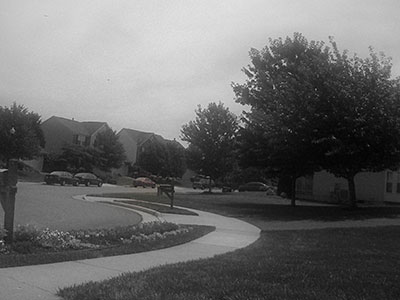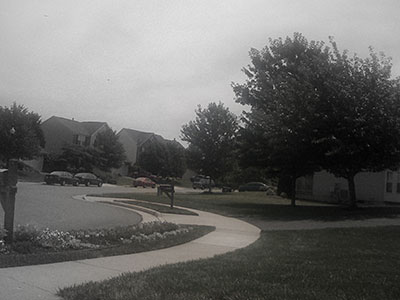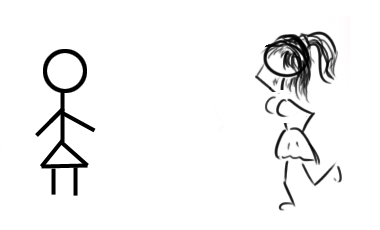
If revenues are the golden eggs, and media/apps/websites the goose, then aggressive, intrusive advertising practices are the hatchet that killed the goose.
The evidence is everywhere.
Broadcast television used to have commercials between shows, then during shows, and eventually digressed to the point where the frequency of continual viewing interruption made it so that certain channels weren’t worth watching anymore. And, oddly enough, to make up for lost revenues, those channels increased the amount of advertising.
From this cable television was born, based on the the idea that if the consumer paid for content, the majority of it would be advertising-free. Although within not much time, advertising leaked in again, and eventually people were back to the old model that used to work: advertising between shows; only this time paying for the privilege.
Then a new consumer product arrived on the market, TiVo, which helped customers skip past commercials; but this early feature was all-to-quickly neutered to fast-forward-only so you’d still have the opportunity to at least see the commercials in the event you wanted to watch one.
While more modern TiVo units now have reintroduced the skip commercial ability, the once clean graphical interface now is littered with dynamic menu choices for products, shows, and offers that appear when you pause to view a frame or try to avoid the commercials.
In response to all this, broadcasters started injecting banners and overlay graphics during the show so you “had” to watch, consuming screen real-estate to announce other shows, products, or news changing the entertainment into a dashboard. Meanwhile producers started injecting product placements into actual content. In the process it means all the display pixels you paid for aren’t being used effectively, it’s distracting to watch, and can lead to some rather embarrassing sexual mishaps between show and ad for the network.
Overall, entertainment quality has gone down, presentation quality has also gone done, consumer costs have gone up, and it’s no wonder we now see a whole generation of cord cutters who have found other means to go straight to content.
The DVD market suffered a similar fate. There was a time when you bought a DVD, you got the movie and possibly special bonus material, and that was all. DVDs started inserting trailers and other commercials at the start of the movie. For a while, consumers would skip to the actual content. Then that capability was removed, and consumers fast-forwarded, which itself was challenged by the now famous “option not available” notice.
In response, streaming services appeared and consumers stopped stocking their media collections at the rate they once had. But now we see pay-for streaming media starting to inject previews and advertising in front of shows. We know where this leads: service termination and few barriers to exiting the moment a new technology surfaces. And it will, it always does.
YouTube’s success led to advertising, not surprisingly at the beginning of a video. And as viewers skipped as soon as possible, a new trend appeared: advertising pop ups over the video. (See a trend?) So while watching content, one is constantly distracted, having to dismiss dialogs; while dealing with that, one isn’t digesting the content. And like we’ve seen before, this leads to platform abandonment.
Other competing video streaming services have started to give rise. It’s surprising, but consumers will often take less content and less quality in exchange for less advertising. YouTube Red emerged as an advertising-free subscription service, just as the cable companies did before. We know where that goes next.
Netflix, Amazon Prime, and HBO were quick to discover that developing high-quality original content would lure viewers, but as more familiar advertising tendencies start to surface, enthusiasm for these platforms dwindles. At some point one starts to ask is the subscription cost justifying actual usage patterns, as consumers are slowly being pushed away. Consumers are becoming more picky while businesses look for augmenting recurring revenue.
Homes all used to have land lines, and as cell phones became cheaper and popular, house holds got them in addition to their highly reliable land lanes. However, with telemarketers invading at all hours, land lines became a dumping ground for calls we didn’t want to take. Services like Caller ID appeared, as well as the national Do Not Call list. However, due to no security in how caller ID works, numbers can be spoofed. Meanwhile, law enforcement has been ineffective at dealing to those breaking the law regarding the no call list, and advertisers for the most part ignore it. Politicians have self-servingly made themselves exempted and are often some of the worse offenders. The result, consumers have disconnected their land lines and are now mostly cell based.
However, it doesn’t take much any more for a new cell phone number to get out into the wild and make it into a robo-caller list. The net result, if someone doesn’t recognize a number, they tend not to pick up. Our cell phones are becoming spam dumps, and once direct access to someone is now fading. Meanwhile, advertisers having grown wise that people are letting content drop to voice mail, and so leave automated recorded messages, which at the end of the sales pitch, one might have the opportunity to be removed from that list (which never gets pressed), although that merely confirms the number works for other endeavors.
This has in turn led to a shift in how we even use phones to communicate, and text messaging is rapidly replacing phone calls. Even now, we’re starting to see advertising start to break into text messaging, initiated by none other than the very carriers of the service.
The home mailbox, originally intended for correspondences and packages, soon became the primary methodology of mass advertising. Consider the signal to noise ratio of your actual mailbox content between what you want verses unsolicited advertising that you have to sort through after each trip to the mail box. The difference in pile size is growing.
With so much volume introducing delay, it’s no wonder that there isn’t a measure of care during processing, and goods often arrive damaged, which in turn devalues most people’s impression of the U.S. Postal Service, their trust in it, and consequently their use.
To avoid postal mail, most people have switched to email and electronic billing; aside from the occasional package from Amazon, there’s relatively little reason to check a postal mailbox on a daily basis anymore.
We will never see postal mail delivering more than once a day as it used to not that long ago with morning and evening deliveries. And because the service is become so bad and fewer people using it, its led at least to discussions of not delivering on weekends.
Services once reserved for over night or over sized deliveries have taken on more casual load once entrusted to the post office. At the moment, advertisers find the service too expensive, so the rate structure is keeping things in check. Should that change, we know what will happen.
Email used to be a way to send messages to one another, and as the population with email addresses grew, advertisers saw it ripe for exploitation. It’s lack of encryption meant that anonymous senders could forge false from addresses and perform automated bulk mailing on a scale of unprecedented magnitude. Worse yet for the unaware receiver, the spammer can often detect if the message was read and use that information to cultivate a list of active emails. If the sender could employ social engineering successfully, it was actually possible to install advertising software on the receiver’s machine — often without them knowing. And best of all for the advertiser, under this model, the receiver pays to receive and store the message!
At this point, it is estimated that 80% of internet traffic is spam. Not emails. Internet traffic. That’s a lot of bandwidth that you’re paying for with 80% of it being used to help other people advertise at little to no cost to them. And the problem is only getting worse.
Despite spam filters, firewalls, and anti-virus software email has gotten so bad that most people have several email accounts, and use one for highly likely spam and another for personal communication. However, the moment one of our contacts shares the personal email address with some bulk email list, it’s relatively little time before it gets compromised and we’re on to another new email address, where the process starts all over, just like folks eventually changed their phone numbers for a little peace.
Websites, attempting to capitalize on traffic, started presenting advertising on the sides of their pages, and later interlaced within the articles themselves. Screaming for visual attention, ads became more gaudy, employed blinking, animation, sound and video, and pop-up dialogs, pop-under dialogs, which soon overwhelmed the value content. Visitors responded with ad blocking tools.
Websites responded by waiting a little bit and then putting a pop-over that blocks out the content below, this obnoxious behavior usually leads to site abandonment as it’s just not worth it. Sometimes, abandonment can’t be avoided: say you’re using the Flipboard app to get your news on an iPhone, it takes you the ScienceNews website, they invoke a non-mobile friendly pop-up, and you can’t see the content nor can you dismiss it. Such websites become dead to visitors.
Admittedly, this may be some interaction between 1Blocker and their advertising code, but seeing that 1Blocker can dramatically speed up load times -and- save on carrier data usage, between it and visiting such a site, 1Blocker wins hands down.
A number of websites have taken the approach that if you don’t let the advertising through, they won’t show the content. Sounds reasonable until you realize they aren’t vetting the advertising content that’s being shown. And malicious advertisers are exploiting that. The consequence of opening a rectangle of any-old content makes solid brand names incidental parties into delivering malware straight to your system. GRC provides a recent list of sites, who just by visiting, have been found to infect machines via advertising services: The New York Times, the BBC, MSN, AOL, Xfinity.com, NFL.com, Realtor.com, TheWeatherNetwork.com, TheHill.com, Newsweek.com, Answers.com, ZeroHedge, and InfoLinks.
A more disturbing practice involves hardware manufactures installing advertising malware in the hardware to make a little extra profit per unit sold. We’ve seen Dell and Gateway load up cruft on new Windows systems, but laptop maker Lenovo built mechanisms into their systems to bypass the end-user’s ability to keep the system clean, even on a pristine reinstall. This practice took them from being one of the most sought after name brands to one to be avoided, all thanks to aggressive and intrusive advertising practices.
Software is no different. Oracle got busted for making the Java installer schedule a background task for a few minutes after installation and then install advertising software; this way the end user wouldn’t notice anything wrong and presumably think it was caused by something else. Both have serious ongoing damaging effects to the Oracle and Java brands in professional circles.
Likewise, many software installer products use deceptive wording to get Ask and Yahoo toolbars installed, all for their own piece of the pie. Both search engines, once considered at least respectable, have lost significant ground to other players from both reputation damage and public mistrust, as well as firewall and ad-blocking rules to prevent installation of such nonsense. Browser owners are encouraged to remove Flash, Silverlight, QuickTime, and Java extensions from their browsers, as this will greatly reduce the attack vector as well as many malicious “advertisement” payloads.
iPhone apps have the ability to show a small banner on occasion or produce a pop-up in the middle of the app. Not only are these practices distracting to the end user, but are reinforced because the more they’re shown, the more revenue made. That makes advertising apps seemingly more profitable than fixed priced apps, which in turn is driving down the amount a professional app can earn.
All of this is changing consumer behavior, and we see app abandonment on the rise, diminished purchasing habits especially in impulse buying, and a noticeable dip in quality and creativity in the available selection.
Even Windows 10 has started to put advertising in its Start Menu and screen saver, and that’s not even counting the aggressive multi-gig push, annoying notifications, deceptive wording on dialog boxes to get you to install it. Such things can not be helping platform adoption.
The evidence is everywhere, aggressive and intrusive advertising practices actually hurts the very distribution platforms that are trying to benefit from it.
We need responsible advertising, not necessarily no advertising.
The Pattern is Clear
Worthwhile content is created, a distribution channel is developed for it, the audience grows. At some point, someone gets the idea that a little advertising will generate a little bit of revenue, and in the short-term it works.
Then the fallacy of if-a-little’s-good—then-a-lot’s-better kicks in, and either the distribution channel gets saturated with ads, the content gets damaged, or the ratio between the two gets so disjoint that the over all value tanks.
Desperation and greed can push the state of things beyond recovery, and what was once a sustainable system no longer has the following it once did, and usually by this time the audience has moved on to other technologies.
Synopsis
- It appears we’re great at repeating history, but neglecting consequences.
- Consumers are willing to pay for great content without advertising.
- Consumers do not want to be distracted by anything else while engaging with content.
- Advertising requires a balance, more isn’t better. It must be done responsibly.
- Intrusive and aggressive advertising leads to platform abandonment.




 Q: What can I do to become a model?
Q: What can I do to become a model?

